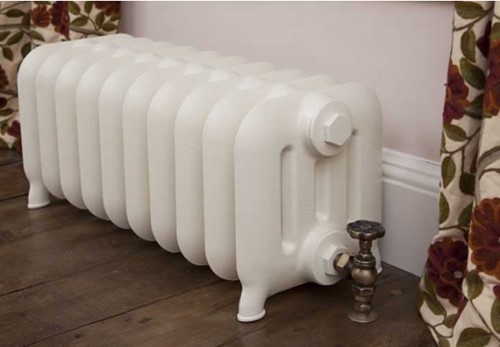Posted: Wednesday, January 6, 2021

When you’re looking for a new or replacement radiator, simply picking out a nice-looking model is one of the last things you should do.
The measurements for a radiator are among the essentials you need to know before going ahead with renovating or installing new radiators in a room. Ensuring you have a note of the correct sizes of your existing radiator provides a foundation for a replacement. But how do you get your measurements spot on?
Well, Trads is here to help ensure a replacement or new radiator fits perfectly into your home heating system…
Sometimes, you are forced into purchasing a new radiator through age and a poorly functioning heater or you want one that’s more in line with your home decor. Replacing your radiator depends on the quality of your installation, the unit itself, and whether it’s been well maintained - this includes its age.
If you are noticing uneven heat distribution or a total absence of heat, then the radiator likely needs replacing. Radiators can be taken for granted because they can last for decades but they will rarely have one big failure, their efficiency declines over years.
Some of the main reasons for replacing a radiator can include:
First of all, you need to know that you’re not just measuring the radiator, you also need the pipes and valves in your measurements. These are the four basic steps to measure a radiator:
It's always important to know the basic height and width of a radiator, whether you're measuring one that’s already in your home or choosing a new one to install.
The wall space of the room you're looking to fit or replace a radiator is only going to have a limited amount of surface area. So, it's important that you know the total length and width of a radiator that will fit in there without preventing you from having tables or other items against the wall.
This step is very simple. Just take your tape measure across the furthest point of your radiator, from one side to the other, for an accurate measurement of width. Then, do the same for the height, use the tape measure from the foot of the radiator to its highest point.
Measuring the radiator to the highest and widest points will ensure that your radiator will fit in the space you've set aside for it. You can then compare this against the measurements of a new or replacement radiator.
Tip: this will be handy to do if you are considering a vertical radiator.
If you're dealing with a standard radiator that will connect to your plumbed hot water central heating system, it's important to measure the ‘pipe centres’ of the radiator.
The pipe centre measurement is the distance between the two pipe inlets at either end on your radiator, where the radiator is connected to your central heating system. If you are replacing an old radiator, then a new radiator with the same pipe centre measurements will allow you to install it straight onto the existing pipes.
Again, with a tape measure, measure from the middle of the left inlet to the middle of the right inlet pipe to record an accurate pipe centre measurement. The pipe centre will be the distance between the pair of pipe inlets.
This measurement is about the distance from the wall that your radiator’s pipe inlets sit as they enter the radiator valves. You should measure from the middle of your pipe inlet to the wall to give an indication as to how far away from the wall your pipework is. This helps avoid any invasive plumbing changes when replacing radiators.
The projection measurement is basically how far your radiator sticks out from the wall, including the gap between the wall and your radiator - wall distance. These measurements are taken from the wall to front, or the furthest point, of the radiator.
The projection measurement isn’t a crucial aspect of a radiator replacement, but it is useful if your new radiators or towel rails are being installed in a compact room with space at a premium - like a bathroom or hallway. Simply measure the furthest point on the face or front of your radiator to the wall.
Wall distance is a useful measurement as it shows you how much space will remain behind your radiator once it’s mounted in place. Just measure from the back of your radiator to the wall to accurately find the size of the gap. This can help if you hang laundry to dry on the radiator.
Once you’ve accurately measured your radiator, you should be in a good position to put them to good use and replace your radiator without having to adjust any plumbing. But there are some other things you will need to consider.
To calculate your BTU, a measure of heat output from a radiator, it will depend on how many radiators are in your room. Alternatively, by entering specific details, such as room measurements, you can find out how many radiators you will need.
If you already have radiators in a room and you want to update them all, you will need to divide the total BTU requirement of the room by the number of radiators. This will calculate the average BTU's required per radiator.
You can use our BTU calculator to discover the size and quantity of radiators needed for a room. You’ll need to make sure you have the following details:
Is it time you updated your radiators? Here at Trads, we have an excellent range of beautiful cast iron and steel radiators to update your home with!
Feel free to contact us if you need any help choosing a radiator
< Back To Blog